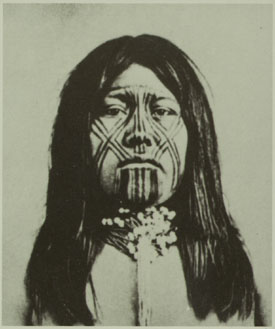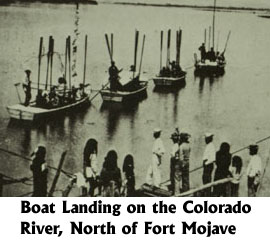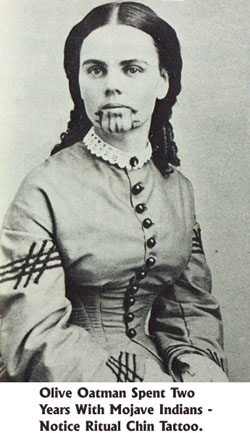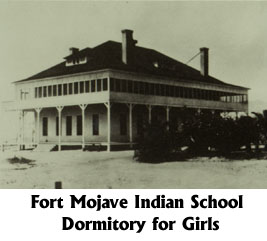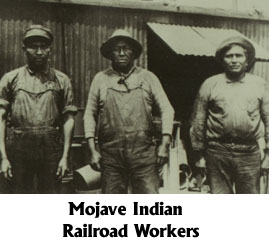Fort Mojave Indians
People Who Live Along The Water(by the Fort Mojave Indian Tribe)
The Beginning
In First Times, there was chaos. And from the union of Earth and Sky was born the Great Spirit Matavilya.
Before he could teach his people all they needed to know about the world, he was killed by his sister, Frog Woman. It was then that his little brother Mastamho took charge of the world and of the people. There were only people then, no animals, birds or fish. Mastamho had to teach the people everything about living, for they knew nothing, not even that they were hungry, thirsty or cold.
He drove a willow stick into the ground and drew out the waters that became the Colorado River, and with the river came fish and ducks. Mastamho made the mountains on both sides of the river using the mud of its banks. He planted seeds of melon, corn, pumpkin and beans in the overflow, so the people would have food to eat.
He taught them to build fire when they were cold, and a shade from the sun when they were hot. He showed them how to build a house, to know day from night. And after he gave them fingers, he taught them how to count. He taught them about the four directions, about the foods they grew, and he showed them how to make pottery vessels in which they could cook and store the food. He made the animals and insects and birds, and he gave the people the names for all things.
Clans, Great Chiefs, Dreams, and The Center Of Existence
The land of the Mojave, the most northern of the Yuman tribes, stretched from Black Canyon to the Picacho Mountains below today’s Parker Dam, straddling the Colorado River.In the 16th Century, the time the Spanish arrived in the territory, the Mojaves were the largest concentration of people in the Southwest. The people who made up the Mojave Tribe lived in three groups - the northern Matha lyathum lived from Black Canyon to the Mojave Valley; the central Hutto-pah inhabited the central Mojave Valley; the territory of the southern Kavi lyathum extended from the Mojave Valley to below Needles Peaks.
The Mojaves live within a clan system that was given to them in First Time by Mastamho. They were named for things above the Earth - the sun, clouds and birds: and for things of the Earth and below the Earth. Mastamho gave the Mojaves 22 patrilinear clans (today that number is reduced to 18), and the children took the name of their father’s clan, though only women used the clan name.
A hereditary chief, called the aha macav pina ta’ahon, along with leaders from the three regional groups of the Mojave, governed the people, but only with their continued support and approval.
The Mojaves were a people of dreams and visions. The dreams, su’mach, were viewed as the source of knowledge. Through them the dreamer could return to the time of creation where the origin of all things would be revealed. Great dreams and visions were related to the tribe as Great Tellings and Sings. They shared the history and legends of the people, deeds of bravery and war, magic and heroes.
And through sumach a’hot, a person was given a gift to do one thing better than others, or called upon to receive a gift of knowledge to know how to cure or treat a special kind of illness. A person called to receive such a gift had to go through much fasting and other trials, sometimes not passing the test and remaining like ordinary people. For those who passed such a test, the Mojaves say of them, "sumach a’hot," they are gifted.
For the Aha Macav, the river was the center of existence. They practiced a dry farming method, relying on the regular overflow of the Colorado River to irrigate crops planted along the banks. Preparation was painstaking; trees were felled, brush cleared. After planting, there was constant weeding and watching for pests. They supplemented this with wild seeds and roots, especially mesquite beans, game and fish taken from the river with traps and nets.
Traders, Potters The Afterlife
The Mojave could be a fierce people willing to protect their land, and willing to venture far from it. They traveled to the Pacific Coast, becoming proficient traders. They exchanged with coastal tribes surplus crops for goods they desired and valued, such as shells.And back along the banks of the river, they made pottery from sedimentary clay and crushed sandstone. The material was coiled into shape, dried, painted and fired in either open pits or rudimentary kilns. They created pots, bowls, ladles and dishes decorated with geometric designs. And the women took the crafts further by making unique pottery dolls for the children, dressing and decorating them like people, complete with human hair.
The art of tattoo was important to the Mojave. They tattooed their faces with lines and dots - a cosmetic, fashionable practice.
And at death, the Mojaves used cremation to enter the spirit world. The property and belongings of the deceased were placed on a pyre along with the body, to accompany the spirits. Mourners often contributed their own valuables as a showing of love. The names of the dead were never again spoken.
Early Contact
Sometimes friendly, sometimes deadly. That describes the early contact between the Mojave and the white man.The search for fortune was what brought the white man to the land of the Mojave. A 1604 expedition in search of silver led New Mexico governor Don Juan Onate through Mojave territory, but it wasn’t until 1775 that Fray Francisco Garces became the first white man to meet the Mojave. His writings reveal the Mojave as friendly. He comments that "the female sex is the most comely along the river, the males very healthy and robust." The men walked naked, the woman wore rabbits and beaver skin capes. He called them Jamajab.
American mountain men led by Jedediah Smith appeared in Mojave territory in 1826, and though the Mojave welcomed the trappers, death and hatred loomed in the future for the two groups.
The Mojave believed all living things belonged where they were placed, so it was hard to understand why the trappers were so brutal, throwing beaver carcasses on the river bank after skinning the animals.
In 1827 another party of trappers led by James Ohio Pattie marched through Mojave territory, ignoring Mojave demands for a horse in trade for the beaver taken from the river. Four days later two white men and 16 Mojaves lay dead.
Late that year Jedediah Smith returned and was attacked, losing nine men, and for the next 20 years violence flared, reaching a peak when trappers from the Canadian Hudson Bay Co. killed 26 Mojave.
In 1850, territory including Arizona was annexed by the United States, and with it began encroachment by the US Army.
The parade was led in 1851 by Capt. L. Sitgreaves, a stern regimentarian, and followed in 1854 by Lt. Amiel Weeks Whipple, an amiable man who gained the confidence of the Mojave. Whipple’s company surveyed and mapped a railroad route from Ft. Smith, Arkansas to the Pacific Ocean, which most Mojaves favored because it meant opportunity for trade.
From 1851 to 1856, the U.S. military was ever present, but it never found out that two white girls, Olive and Mary Ann Oatman, were living with the Mojave. Captured by the Tonto Apaches in 1851, they were traded to Mojave Chief Espaniol for two horses, some vegetables, several pounds of beans and three blankets. The younger, frail Mary Ann died in 1854, probably from malnutrition. Olive, at 16, was returned to her relatives in 1856.
The story made national headlines and raised a furor among non-Indians. The girls, from the Mojave point of view, were lucky to have fallen into their hands, away from the Tonto Apaches. Under the circumstances, they were fortunate. The chief attached them to his household, and they were afforded the best Mojave facilities, seeds for planting, love, divergence from Mojave customs.
In 1858 the seeds of Fort Mojave were planted when Lt. Edward Beale and troop of 12 camels cleared and opened a wagon road along Whipple’s survey route. He suggested a fort be built to guard the river crossing near present-day Needles. In August a wagon train that lingered too long near the crossing was attacked.
Spurred by public clamor to "Wipe out the Mojave!" 700 Indian fighters led by Col. William Hoffman were sent in 1859 from San Francisco. Though there was no combat, and the Mojaves insisted that the attack was instigated by the Hualapais, Col. Hoffman on April 24 threatened to take the Great Chief Homoseh awahot to Yuma Prison as a hostage to show the Mojaves the might of the US Government.
The great chief was elderly, so his nephews, along with the sub-chief Cairook, went in his place. They were told releases would be in one year, but a year passed, so an escape was planned. By holding the lone guard at noon while the other, younger hostages dived into the river, swimming underwater to escape, Cairook gave his life.
Years of Change
The late 1800s were years of change for the Mojave. In 1861, constraints of the American Civil War forced the military to abandon Ft. Mojave. Tribal leadership was in upheaval as the Great Chief Homoseh awahot relinquished his post to Yara tav, who favored peace with the Americans. He had seen their power, having traveled to Los Angeles, San Francisco and to Washington, DC to visit President Lincoln.In March 1865 the US Government created the Colorado Indian Reservation near Parker, the southern range of the Mojave. Yara tav, though disapproving of the poor farmland, led 500 to 800 Mojaves to the new reservation at Parker Valley. Homoseh awahot resumed his post as great chief to lead those who refused to leave the Mojave Valley. The people were split into two tribes.
Homoseh awahot was succeeded by his son Empote awatacheech, John Potachecha in 1875, who when he died two years later was succeeded by his 8-year old son Hobelia.
Those living around the fort were called Ft. Mojaves when the building and 14,000 acres were transferred from the War Department to the Interior Department in 1890. The fort became an industrial boarding school for the Ft. Mojave and other non-reservation Indians.
The plan was to eradicate native language and culture. A compulsory education law was passed, and truant children forcibly returned to school were often whipped and locked in an attic for days, and given water and a slice of bread for meals.
The Indians were taught Anglo farming methods, but with no land of their own, they looked elsewhere for work. Many turned to the Atlantic and Pacific Railroad (later the Santa Fe), which came to Needles in 1883. Others worked on river boats, in the mines, some sold beadwork and pottery dolls to train tourists. The Mojave became urban Indians living in Needles.
The Great Chief Hobelia, now 10 years old, went to school in 1892, his name anglicized to Pete Lambert. He was the last great chief of the Mojaves. In 1905 students were required to adapt English surnames in place of their traditional clan and individual names.
In 1911, by executive order, the Ft. Mojaves were granted a reservation consisting of the old military reserve, areas called the hay and wood reserves on the California and Nevada side of the Colorado River, and adjacent checkerboard land on the Arizona side, a total of about 31,300 acres. The checkerboard arrangement came about because the government gave the railroad every other section of land.
The boarding school closed in 1931, and children began attending school in Needles. The 20th Century was closing in. In 1936 a great flood washed out Mojave homes in Arizona, Needles too was flooded. To replace these homes, a new village was built outside Needles in 1947 on land bought by the tribe, and later declared part of the reservation.
The traditional tribal leadership was changed forever in 1957 with the approval of the Ft. Mojave Constitution, and with it the creation of a seven member tribal council.
Making up that first council were tribal chairman Francis Stillman, vice chairman Hubert McCord, and council members Claude Lewis, Joe Davidson, Rudolph Bryan, and husband and wife Harwood and Minerva Jenkins.
